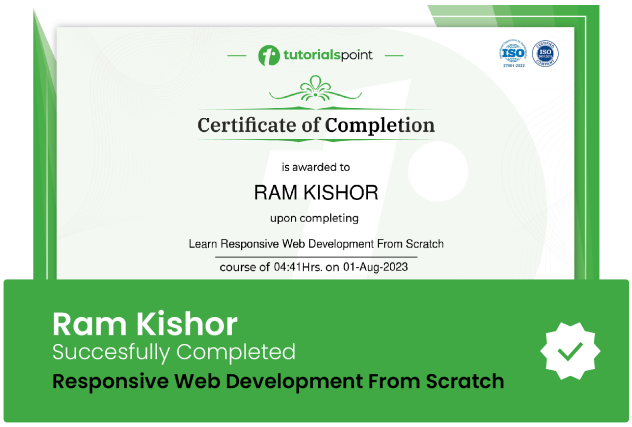thank you
Learn SolidWorks from scratch to expert Level
SolidWorks – A Powerful 3D design solution for rapid creation of parts, assemblies and 2D drawings.

Lectures -68
Duration -18 hours

Get your team access to 10000+ top Tutorials Point courses anytime, anywhere.
Course Description
SolidWorks 2015
A Powerful 3D design solution for rapid creation of parts, assemblies and 2D drawings with minimal training.
Friends!
Every one of us has certain design requirements that we want to accomplish. In the whole life of a Design Engineer, there are certain areas that he works in full expertise. But rest of the features in a CAD solution die useless for him. He even wants to put a glance on them all his life. So if the software is too complex, the Design Engineer will feel more troubled with those useless features which He is not going to use. They work like road blocks at times in his life without him getting a cue of what to do with it.
Now here is the real dilemma with a CAD solution:-
1. It needs to be specific to a particular user and should not offer more than what he actually needs.
2. But in the meantime, it should be usable by all the designer community. It can’t be customized solution for each individual due to very high incurring costs.
Why to use SolidWorks 2015?
So here is the solution: - SolidWorks 2015
It has rich and complex functionalities and design capabilities that one can use with a simple and dynamic interface. You can pick up desired functionalities at your active interface and hide useless ones from the active interface. The rules of this ‘Game’ fairly simple and comprehensive. You can easily learn them and work out any design of your choice with use of your mind.
What we can do with SolidWorks
1. We can make up new parts, assemble them and then create drawings for the parts or the assemblies.
2. Further we can assign material to a part and get its mass-volume properties.
3. We can test a part or an assembly of moderate complexity under various loading conditions. We can analyze how much the part will bend under what force, how much force it will bear and hence optimize our design for least material required for any specific loading requirement.
4. We can see how the fluid flows through a part or an assembly of part using SolidWorks FloXpress.
5. Other than this, we can analyze the stress behavior of a critical part in motion, calculate various dynamic functions of a part in motion.
6. You can create models of Printed Circuit Boards (PCB) using CircuitWorks which function like a real circuit.
7. You can use SolidWorks Costing to work out the cost of production by specifying the costs of materials used and processes applied.
8. Using SolidWorks Design Checker, you can check dimensioning standards, fonts, materials, sketches and other design elements as against the specified design criteria.
9. You can verify whether can part can be manufactured or not using DFMXpress.
10. A path of pipes, tubes or electrical cables can be built between components using SolidWorks Routing.
There are many more to explore in SolidWorks.
Why choose for our Video Series?
We cover every possible design element of SolidWorks that is going to be of your use.
In each of our video, we do not put up only the selected parts of the tutorial video. We show you from start to finish giving you the intricate details and showing you how it goes in real life. Any function failure is seen in many of the videos which give you a good idea of what to do and what not to do.
In every video, we start from zero so that you are not hung at any stage of designing without having a clue of getting out of it. Following our video tutorials, you can very easily learn the parts.
We show you the designing of products that are actually accomplished in the design industry. Things are practical, not theoretical. You know what the difference between theoretical and practical one is.
Goals
- What we can do with SolidWorks 1. We can make up new parts, assemble them and then create drawings for the parts or the assemblies.
- 2. Further we can assign material to a part and get its mass-volume properties.
- 3. We can test a part or an assembly of moderate complexity under various loading conditions. We can analyze how much the part will bend under what force, how much force it will bear and hence optimize our design for least material required for any specif
- 10. A path of pipes, tubes or electrical cables can be built between components using SolidWorks Routing.
Prerequisites
- Basic knowledge of computer and SolidWorks 2015 software or higher version

Curriculum
Check out the detailed breakdown of what’s inside the course
Introduction
67 Lectures
-
1.1.1.1 Part Sketch 2D Line 24:55 24:55
-
1.1.1.2 Part Sketch 2D Circle Polygon 08:29 08:29
-
1.1.1.3 Part Sketch 2D Rectangle Fillet 16:47 16:47
-
1.1.1.4 Part Sketch 2D Spline Slot Arc Ellipse 18:11 18:11
-
05 Part Sketch 2D Text Point 06:52 06:52
-
06 Part Sketch 2D Trim 09:31 09:31
-
07 Part Sketch 2D Offset Mirror Pattern Move Copy Rotate Scale Stretch 22:16 22:16
-
08 Part Sketch 2D Rapid Sketch 03:06 03:06
-
09 Part Sketch 3D Plane Convert Intersection 13:09 13:09
-
Part Sketch Zoom 03:47 03:47
-
11 Part Sketch Keyboard Shortcut Relation 12:52 12:52
-
12 Part Sketch More Keyboard Shortcuts 09:24 09:24
-
14 Part Sketch View 02:52 02:52
-
1.1.4 Part Sketch Importing an Image 09:12 09:12
-
1.1.5 Part Sketch Block.mp4 08:40 08:40
-
1.1.6 Part Sketch Smart Dimension 14:55 14:55
-
1.1.7 Part Sketch Belt Chain 06:34 06:34
-
1.1.8 Part Sketch Replace Entity 06:14 06:14
-
1.1.9 Part Sketch Giving Color, Thickness and Style to a Sketch Entity 03:03 03:03
-
21 Part Feature Extrude 1 48:25 48:25
-
1.2.1.2 Part Feature Extrude 2 23:37 23:37
-
1.2.2 Part Feature Saving in many file formats 13:00 13:00
-
1.2.3 Part Feature Revolve 11:18 11:18
-
1.2.4 Part Feature Extruded Cut Fillet 33:51 33:51
-
1.2.5 Part Feature Revolved Cut 06:43 06:43
-
1.2.6 Part Feature Section View 06:14 06:14
-
1.2.7 Part Feature Loft 33:34 33:34
-
1.2.8 Part Feature Sweep 20:08 20:08
-
1.2.9 Part Feature Lofted Cut 09:09 09:09
-
1.2.10.1 Part Feature Swept Cut 1 12:09 12:09
-
1.2.10.2 Part Feature Swept Cut 2.mp4 06:43 06:43
-
1.2.11 Part Feature Boundary Boss.mp4 08:06 08:06
-
1.2.12 Part Feature Boundary Cut.mp4 11:24 11:24
-
1.2.13 Part Feature Linear Circular Pattern.mp4 15:57 15:57
-
1.2.14 Part Feature Rib.mp4 07:26 07:26
-
1.2.15 Part Feature Draft.mp4 02:27 02:27
-
1.2.16 Part Feature Shell.mp4 03:40 03:40
-
1.2.17 Part Feature Wrap.mp4 22:27 22:27
-
1.2.18 Part Feature Mirror.mp4 04:59 04:59
-
1.2.19 Part Feature Helix Spring Thread Unified Inch. 53:21 53:21
-
1.2.20 Part Feature Instant 3D Rebuild.mp4 06:54 06:54
-
1.2.21 Part Feature Surface Extrude Intersect.mp4 15:58 15:58
-
1.2.22 Part Feature Surface Revlove.mp4 02:36 02:36
-
1.2.23 Part Feature Surface Sweep.mp4 04:47 04:47
-
1.2.24 Part Feature Loft and Trim Surface.mp4 25:31 25:31
-
1.2.25 Part Feature Boundary Surface.mp4 14:27 14:27
-
1.2.26 Part Feature Surface Freeform.mp4 19:35 19:35
-
1.2.27 Part Feature Filled Surface.mp4 20:34 20:34
-
1.2.28 Part Feature Ruled Surface.mp4 11:28 11:28
-
1.2.29 Part Feature Surface Planar Offset Flatten Fillet Delete Replace Extend.m 35:00 35:00
-
1.2.30 Part Feature Surface Untrim Knit Thicken Thickened Cut Cut with Surface.m 27:06 27:06
-
1.2.31 Part Feature Curve Project Curve Composite Curve and Curve thru Reference 09:55 09:55
-
1.2.32.1 Part Feature Gear Involute.mp4 40:33 40:33
-
1.2.32.2 Part Feature Gear Spur Using Equation in Smart Dimension.mp4 31:38 31:38
-
1.2.32.3 Part Feature Gear Rack and Pinion.mp4 38:11 38:11
-
1.2.32.4 Part Feature Gear Helical Herringbone.mp4 31:06 31:06
-
1.2.32.5 Part Feature Gear Rack with Helical Pinion. 21:04 21:04
-
1.2.32.6 Part feature Gear Worm and Worm Wheel.mp4 01:15:34 01:15:34
-
1.2.32.7 Part Feature Bevel Gear.mp4 42:19 42:19
-
1.2.33 Part Feature Reorder a Feature.mp4 05:40 05:40
-
1.2.34 Part Feature Scale.mp4 09:31 09:31
-
1.2.35 Part Feature Insert Part Move or Copy Body Indent.mp4 19:32 19:32
-
1.2.36.1 Part Feature Deform Point.mp4 10:11 10:11
-
1.2.36.2 Part Feature Deform Curve to Curve.mp4 05:56 05:56
-
1.2.36.3 Part Feature Deform Surface Push.mp4 11:54 11:54
-
1.2.37 Part Feature Flex Bend Twist Taper Stretch.mp4 09:06 09:06
-
1.2.38 Part Feature Combine Bodies Split Body Delete Body.mp4 06:26 06:26
Instructor Details

Sanjeev
Course Certificate
Use your certificate to make a career change or to advance in your current career.

Our students work
with the Best


































Feedbacks
it is amazing
very good
very helful
very helpful
excellent
It is very easy to understand and explanation makes it very easy to grasp hard concept
n
very help full
Very Good Explanation
Related Video Courses
View MoreAnnual Membership
Become a valued member of Tutorials Point and enjoy unlimited access to our vast library of top-rated Video Courses
Subscribe now
Online Certifications
Master prominent technologies at full length and become a valued certified professional.
Explore Now



 Updated on Jul, 2024
Updated on Jul, 2024
 Language - English
Language - English